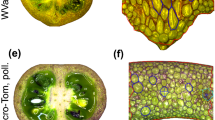Abstract
Fruit sink strength or its ability to attract assimilates depends bothon sink activity and size. This study investigated one main component of sinksize, that is the number of fruit cells during tomato plant development. Plantswere grown in a controlled climate chamber under a limiting (LS, six fruits pertruss) and non-limiting (NLS, two fruits per truss and CO2enrichment) supply of carbon assimilates. Under NLS conditions, fruit cellnumber was homogeneous among successive trusses, and fruits contained onaverage1.2 × 106 more cells than under LS conditions,though differences were not significant on the first truss which underwent thelowest competition. Under LS conditions, an ontogenetic increase in cell numberwas observed in proximal fruits of the upper trusses attributed to theenlargement of the apical meristem during plant development. The decrease ofcell number from proximal to distal fruits within a truss, that was expectedfrom the literature, was generally observed in the LS experiment, with anaverage significant difference of about1.6 × 106cells between the first and fifth fruits. Nevertheless, whereas the gradient incell number from proximal to distal fruits was steep in the upper trusses, itwas not significant on the lower trusses indicating that this gradient largelydepended on the level of competition during floral development. Thus, under lowassimilate supply, cell division is a main limiting factor for fruit growth,although cell enlargement during further fruit development is also affected,butwas not measured in this work.
Similar content being viewed by others
References
Bangerth F. and Ho L.C. 1983. Fruit position and fruit set sequence in a truss as factors determining final size of tomato fruits. Annals. of Botany 53: 315–319.
Bertin N., Gary C., Tchamitchian M. and Vaissiere B.E. 1998. In-fluence of cultivar, fruit position and seed content on tomato fruit weight during a crop cycle under low and high competition for assimilates. Journal of Horticultural Science and Biotechnology 73: 541–548.
Bohner J. and Bangerth F. 1988a. Effects of fruit set sequence and defoliation on cell number, cell size and hormone levels of tomato fruits (Lycopersicon esculentum Mill. within a truss. Plant Growth Regulation 7: 141–155.
Bohner J. and Bangerth F. 1988b. Cell number, cell size and hormone levels in semi-isogenic mutants of Lycopersicon pimpinellifolium differing in fruit size. Physiologia Plantarum 72: 316–320.
Bünger-Kibler S. and Bangerth F. 1983. Relationship between cell number, cell size and fruit size of seeded fruits of tomato (Lycopersicon esculentum Mill., and those induced parthenocarpically by the application of plant growth regulators. Plant Growth Regulation 1: 143–154.
Cowan A.K., Moore-Gordon C.S., Bertling I. and Wolstenholme B.N. 1997. Metabolic control of avocado fruit growth. Plant Physiology 114: 511–518.
Cockshull K. and Ho L.C. 1995. Regulation of tomato fruit size by plant density and truss thinning. Journal of Horticultural Science 70: 395–407.
De Koning A.N.M. 1994. Development and dry matter distribution in glasshouse tomato: a quantitative approach. PhD Dissertation, Wageningen Agricultural University, Wageningen.
Gyllaspy G., Ben-David H. and Gruissem W. 1993. Fruits: a developmental perspective. The Plant Cell 5: 1439–51.
Heuvelink E. 1996. Dry matter partitioning in tomato: validation of a dynamic simulation model. Annals of Botany 77: 71–80.
Higashi K., Hosoya K. and Ezura H. 1999. Histological analysis of fruit development between two melon (Cucumis melo L. reticulatus) genotypes setting a different size of fruit. Journal of Experimental Botany 50: 1593–97.
Ho L.C. 1980. Control of import into tomato fruits. Berichte der Deutschen Botanischen Gesellschaft 93: 315–25.
Ho L.C. 1992. Fruit growth and sink strength. In: Marshall C. and Grace J. (eds), Fruit and seed production: aspects of development, environmental physiology and ecology. SEB Seminar Series 47, Cambridge, pp. 101–124.
Ho L.C. 1996. Tomato. In: Zamki E. and Shaffer A.A. (eds), Photoassimilate distribution in plant and crops. Marcel Dekker, Inc, New York, pp. 709–728.
Jackson D.I. and Coombe B.G. 1966. The growth of apricot fruit. I. Morphological changes during development and the effects of various tree factors. Australian Journal of Agricultural Research 17: 465–77.
Kinet J.M. 1982. Un abaissement de la température et une élévation de la teneur en CO2 de l'atmosphère réduisent l'avortement des inflorescences de tomates cultivées en conditions d'éclairement hivernal. Revue Agricole 35: 1767–1772.
Kinet J.M. 1989. Environmental and chemical controls of flower development. In: Lord E. and Bernier G. (eds), Plant reproduction: from floral induction to pollination. Vol. I. The American Society of Plant Physiologist Symposium Series, pp. 95–105.
Kinet J.M., Zune V., Linotte C., Jacqmard A. and Bernier G. 1985. Resumption of cellular activity induced by cytokinin and gibberellin treatments in tomato flowers targeted for abortion in unfavorable light conditions. Physiologia Plantarum 64: 67–73.
Le Bot J., Adamowicz S., Robin P., Andriolo J.L. and Gary C. 1998. Modelling nitrate uptake by greenhouse tomato crops at the short and long time scales. Acta Horticulturae 456: 237–245.
Mapelli S., Frova C., Torti G. and Soressi G.P. 1978. Relationship between set, development and activities of growth regulators in tomato fruits. Plant and Cell Physiology 19: 1281–88.
Pearce B.D., Grange R.I. and Hardwick K. 1993. The growth of young tomato fruit. I. Effects of temperature and irradiance on fruit growth in controlled environment. Journal of Horticultural Science 68: 1–11.
Walker A.J. and Ho L.C. 1977. Carbon translocation in the tomato: carbon import and fruit growth. Annals of Botany 41: 813–23.
Author information
Authors and Affiliations
Corresponding author
Rights and permissions
About this article
Cite this article
Bertin, N., Gautier, H. & Roche, C. Number of cells in tomato fruit depending on fruit position and source-sink balance during plant development. Plant Growth Regulation 36, 105–112 (2002). https://doi.org/10.1023/A:1015075821976
Issue Date:
DOI: https://doi.org/10.1023/A:1015075821976




